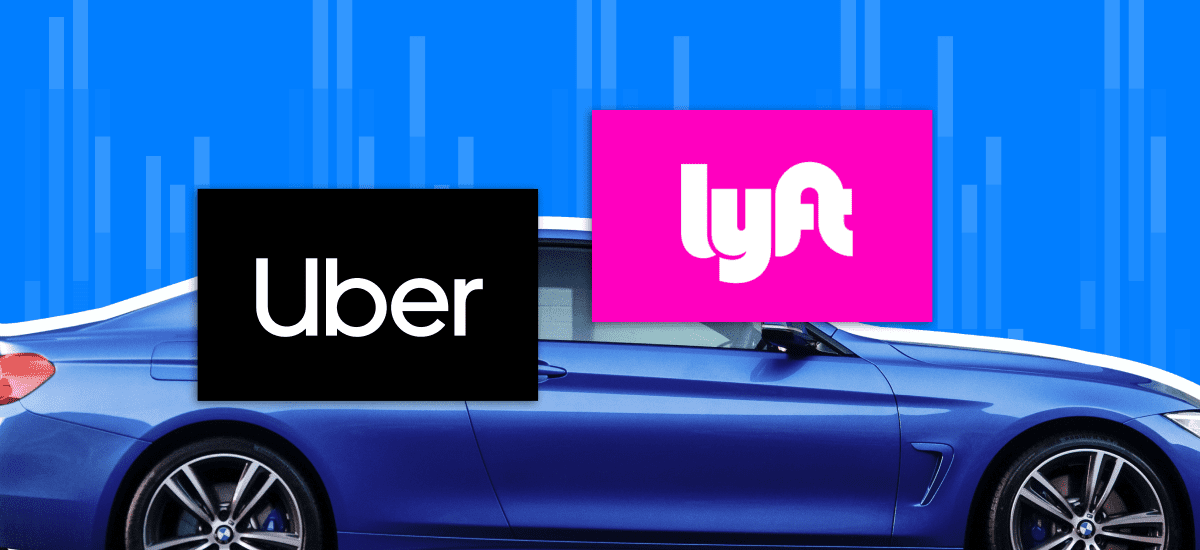This week, Uber and Lyft reported earnings after both announced layoffs as a part of cost-cutting measures. How did these two gig economy giants fare amidst shelter-in-place orders and decreased demand across the globe?
Here are the highlights:
- Uber saw its two primary business lines completely diverge with Eats Net Revenue growing by 124%
- Lyft reported 23% Revenue growth which beat consensus expectations by ~7% and EBITDA losses fell to just $85m which was ~$100m better than expectations
- Uber previewed new business lines signaling the need to accelerates omnicommerce
- Lyft should exit this crisis with a leaner cost structure, healthy supply, and improved unit economics
Below, you’ll find analyst commentary paired with quotes pulled directly from Uber and Lyft’s earnings call transcripts. Interested in keeping track of tech stocks? Start your free trial of AlphaSense now or login to your account.
Please note highlighting:
Green highlights: positive sentiment
Red highlights: negative sentiment
Uber Earnings: Q1 2020
UBER saw its two primary business lines completely diverge. The Uber Eats business inflected and has continued to accelerate into May, while the Rideshare business fell 80% in April as a result of global shelter-in-place orders. The net result was in-line Gross Bookings (beating Consensus expectations on Eats and missing Rides), a 1% beat on Adjusted Net Revenue, and a significantly smaller loss than expected (-$612m Adj EBITDA vs. -$733m Street). As a result of improving unit economics and >$1bn of cost savings, Uber expects to achieve profitability on a consolidated basis in 2021.
Rides was firing on all cylinders through February with Gross Bookings up nearly 20%, Gross Bookings ex-Shared Rides (which they’ve pulled back on) up mid-20s, and Adjusted Net Revenue up high-20s. Rides Adjusted EBITDA margins reached 30%. In March, the landscape changed significantly as a result of Shelter-in-Place orders, resulting in rides down 80% in April. Similar to Lyft, Uber provided some commentary on the trajectory of improvement off the bottom. While the bottom seems to be in, rides remain down 70% even in Texas and Georgia.
Finally, I want to talk about what we’re seeing in our Rides business today and I won’t sugarcoat it. COVID-19 has had a dramatic impact on Rides, with the business down globally around 80% in April. Still, there are some green shoots driving restrained optimism. We’ve seen week-on-week growth globally for the past 3 weeks. This week is tracking to be our fourth consecutive week of growth. Last week, we saw 9% trip growth and 12% gross bookings growth globally week-on-week. We believe the U.S. is off the bottom. U.S. gross bookings were up last week by 12% overall week-on-week, including New York City up 14%, San Francisco up 8%, Los Angeles up 10% and Chicago up 11%. Perhaps more interestingly, gross bookings in large cities across Georgia and Texas, these are 2 states that have started opening up significantly, are up substantially from the bottom at 43% and 50%, respectively. Hong Kong is back to 70% of precrisis gross bookings levels. And in India, we began operating again in designated green and orange zones which account for more than 80% of the country’s 733 districts. In France, a survey of riders who are active before COVID shows 2/3 expect to take their next Uber ride within a month. 90% expect to do the same in less than 3 months, and 98% of all riders say they will take a trip again, suggesting pre-COVID usage will build back steadily.
Eats Net Revenue grew 124% driven by Gross Bookings up 54% and the net take-rate expanding to 11.3%. The business accelerated to 89% Gross Bookings growth in April and strengthened further in May, reaching a $25bn GMV run-rate. Net revenue should continue to grow even faster as mix continues to shift towards SMBs. Importantly, Dara also hinted at a new high margin revenue stream being introduced for the Eats business: Promoted Listings.
Eats gross bookings of $4.7 billion grew 54% on a constant currency basis driven by continued tailwinds from stay-at-home orders in the U.S. and international markets. Eats ANR of $527 million, up 124% on a constant currency basis due to a mix shift towards small and medium-sized restaurants driving higher basket sizes, coupled with courier payment efficiencies, mainly in the U.S. Excluding Eats India, which we divested to Zomato in January of this year, Eats take rate was 11.6%. This represents a significant 150 basis point improvement quarter-on-quarter, which puts us well on our path to achieving our 15% long-term take rate target. Importantly, we are confident these take rate improvements are structural improvements.
Management called out a “tremendous increase” in restaurant sign-ups, in part driven by behavioral shifts such as the willingness of higher-end restaurants to sign up for delivery. This is leading to better selection and higher conversion. In conjunction with the “millions” of new customers trying the category, this should lead to a healthier marketplace – which management now thinks will be multiples bigger than prior expectations. That said, the growth in the category will likely to continue to attract capital, which could delay consolidation.
We’ve seen an enormous acceleration in demand since mid-March with 89% year-over-year gross bookings growth in April, excluding India. And just last week, Eats crossed the $25 billion gross bookings annual run rate. Additionally, there’s been a tremendous increase in restaurant sign-ups, leading up to rapid improvement in selection in major markets like the U.S. as well as behavioral shifts, like the willingness on the part of fine-dining establishments to sign up for delivery. We believe these trends are here to stay and will result in an expansion of the entire category.
Finally, Uber previewed their new business lines: Uber Grocery and Uber Direct (B2B and B2C package delivery). Their entry into grocery will be accelerated by their acquisition of Cornershop which is expected to close in the next few months. Amazon has used similar Uber-like delivery partners for years and the rest of retail likely sees an increased urgency to pursue these options as COVID-19 accelerates the need for omnicommerce. Both of these expand the TAM and increase earnings opportunities for drivers.
Lyft Earnings: Q1 2020
LYFT reported 23% Revenue growth which beat consensus expectations by ~7% and EBITDA losses fell to just $85m which was ~$100m better than expectations. EBITDA margins improved a massive 19pts year-over-year and 400bps sequentially, driven by market rationalization. LYFT stock rose >20% as results displayed the strength in the business leading up to shelter-in-place orders and commentary on the path to profitability eased concerns.
Of course, the business was abruptly impacted from COVID-19: rides fell 75% in April. Lyft has begun to see signs of a recovery with three consecutive weeks of week-over-week growth, but rides remain down >70% from peak.
Here are the facts. In mid-March, we began to experience a sharp decline in rides as various authorities across North America issued guidelines and orders for residents to minimize time spent outside their homes and apartments. For the month of April, rideshare rides were down 75% year-over-year. Ride levels appear to have stabilized, seeming to have reached a bottom in the second week of April. We have since seen 3 consecutive weeks of week-on-week growth, but clearly this is from a low absolute ride base and rides last week were still down more than 70% year-on-year.
Management provided some city-specific commentary on the move from the bottom:
Now let me provide some city-specific details to help answer your question as well. We are seeing what may be beginning signs of a recovery in certain cities. But I want to caveat, again, this is from a low base. In terms of April’s entry and exit ride volume, so again, I’m comparing the week ending April 5th and the most recent week, the week ending May 3rd, rideshare rides increased 25% in Atlanta, 35% in Chicago, 29% in Houston, 39% in New Orleans, 22% in New York City, and finally, 25% in Seattle. And this is relative to the 13% that I mentioned for the overall company in terms of the rideshare platform.
And then finally, just so you have the most recent data points versus some of the cities. This is looking at week-over-week growth for the week ending Sunday, May 3rd. We saw the following: in Las Vegas, rides grew 22% week-on-week. Nashville grew at 16% week-on-week. Moving to Florida, Miami grew at 15% week on week, Orlando at 14% week-on-week. And then finally, Texas, Austin at 16% week-on-week; and then Houston at 12% week-on-week. And again, this is overall — relative to the overall business, which grew rideshare rides 7% week-on-week. Now again, keep in mind, these are from a low base. But all of these cities that I mentioned in terms of week-over-week growth, this is the third consecutive week of positive week-on-week growth as well.
As a result of the drop in ride volume, management implemented a cost-savings program which will take out $300m cost per year. These cost savings along with improvements in unit economics from Insurance leverage should allow the Company to break-even on ride volume 15-20% lower than originally forecasted.
Management said that even if Rides remained down 75% year-over-year (a level they’ve already begun improving off of) for the remainder of the quarter, Lyft would keep EBITDA losses under $360m. That’s before the bulk of the $75m of quarterly cost savings kick in by Q4’20. With color on the 2/3rds variable, 1/3rd fixed cost structure, Lyft should breakeven somewhere around $1.1bn of quarterly Revenues – a level they were on pace to hit in Q1’20 prior to Covid-19.
Given this fluidity, it is impossible for us to predict with any certainty our results for the second quarter. As such, we are providing investors with an estimate of Adjusted EBITDA loss based on April ride volumes. More specifically, if rides on our rideshare platform remained at April levels, which were down approximately 75% year-over-year for the remainder of the quarter, we expect we can manage to keep our Q2 adjusted EBITDA loss to under $360 million. This figure excludes restructuring costs that I previously mentioned.
With $2.7bn of Unrestricted Cash, Lyft has plenty of cash to reach breakeven (and potentially more levers to pull, if necessary, between their Self-driving investment and Bikes and Scooters). That said, management does leave open the door to raising capital and highlights minimal debt on the balance sheet today.
Answer – Brian Keith Roberts: Sure. So look, as we mentioned, we do have $2.7 billion of basically cash. So we feel we’re in a very strong position. We made some pretty decisive decisions to reduce the cash burn for this year in terms of the $300 million of fixed costs we’re taking out as well as we’re funding new initiatives to improve unit economics, which would be on top of the $300 million. And then finally, we did lower capex from $400 million down to $150 million. So all of those initiatives will obviously help us preserve cash. So we believe we are sufficiently capitalized to reach free cash flow breakeven. So we don’t think we need to raise capital. But look, we’re always willing to be opportunistic. I will call out our long-term debt stands at a whopping $82 million right now.
Importantly, driver supply remains very strong – outstripping demand and forcing Lyft to suspend new driver sign-ups. Rideshare will likely be one of the first places the newly unemployed go to generate income which will be important as demand returns and may shift the regulatory discussion. Lyft should exit this crisis with a leaner cost structure, healthy supply, and improved unit economics. The question is how consumer behavior shifts and what the shape of a recovery looks like.



